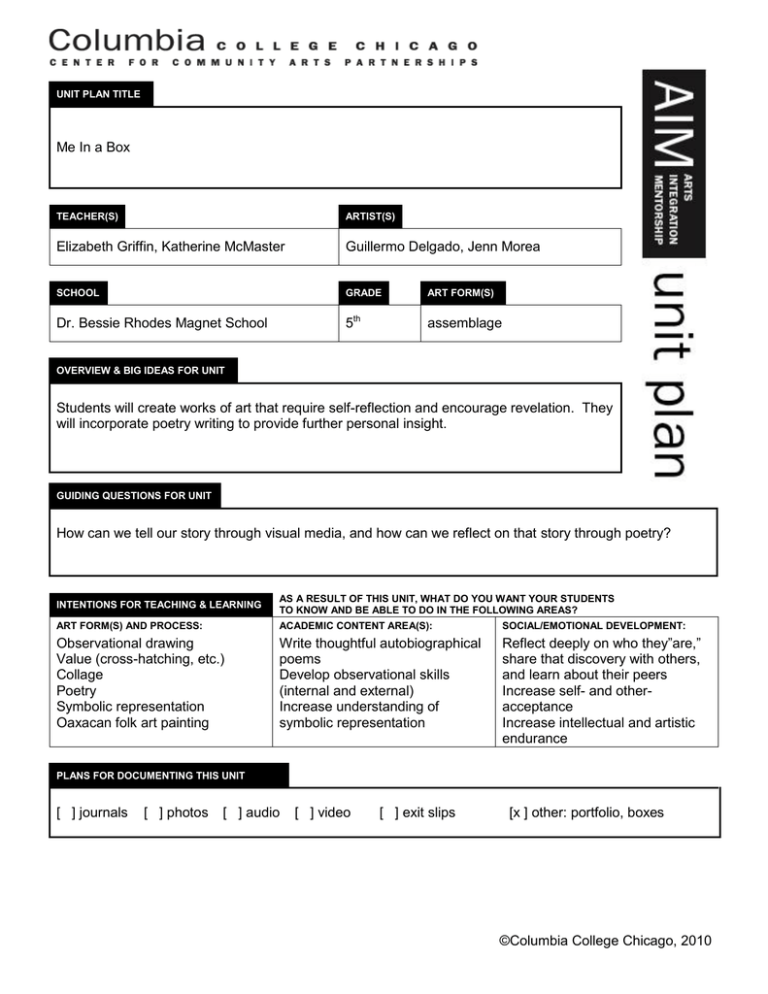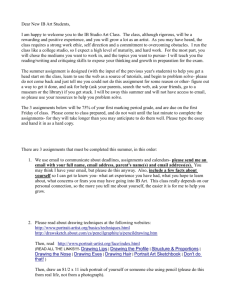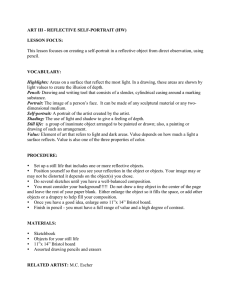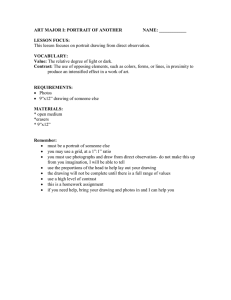Me In a Box Elizabeth Griffin, Katherine McMaster Guillermo Delgado, Jenn Morea
advertisement

UNIT PLAN TITLE Me In a Box TEACHER(S) ARTIST(S) Elizabeth Griffin, Katherine McMaster Guillermo Delgado, Jenn Morea SCHOOL GRADE ART FORM(S) Dr. Bessie Rhodes Magnet School 5th assemblage OVERVIEW & BIG IDEAS FOR UNIT Students will create works of art that require self-reflection and encourage revelation. They will incorporate poetry writing to provide further personal insight. GUIDING QUESTIONS FOR UNIT How can we tell our story through visual media, and how can we reflect on that story through poetry? INTENTIONS FOR TEACHING & LEARNING AS A RESULT OF THIS UNIT, WHAT DO YOU WANT YOUR STUDENTS TO KNOW AND BE ABLE TO DO IN THE FOLLOWING AREAS? ART FORM(S) AND PROCESS: ACADEMIC CONTENT AREA(S): SOCIAL/EMOTIONAL DEVELOPMENT: Observational drawing Value (cross-hatching, etc.) Collage Poetry Symbolic representation Oaxacan folk art painting Write thoughtful autobiographical poems Develop observational skills (internal and external) Increase understanding of symbolic representation Reflect deeply on who they”are,” share that discovery with others, and learn about their peers Increase self- and otheracceptance Increase intellectual and artistic endurance PLANS FOR DOCUMENTING THIS UNIT [ ] journals [ ] photos [ ] audio [ ] video [ ] exit slips [x ] other: portfolio, boxes ©Columbia College Chicago, 2010 PLANS FOR ASSESSING STUDENT LEARNING/DEVELOPMENT 1. observational shoe drawing 2. looking at art, writing activity 3. Review portfolio and do a reflective writing on personal growth through the AIM experience TEXT & IMAGE SOURCES OF INSPIRATION / MODEL ARTWORKS ENGAGE Joseph Cornell Oaxacan folk art traditions WEEK 1 ART AND ACADEMIC CONTENT VOCABULARY 1) assemblage 2) masterpiece 3) value 4) spectrum 5) dexterity 6) endurance 7) juxtapose 8) symbolism 9) anaphora 10) Creative license EQUIPMENT & MATERIALS Sharpie markers Drawing paper Wooden boxes Gesso Paint brushes Paint Nails Colored tissue paper Mirrors CREATE A SAFE COMMUNITY OF LEARNERS | LEARNING THE LANGUAGE OF THE ARTS Shoe drawing Map of journey from home to school (symbolic expression) Looking at art, responding through guided writing 2 3 IMMERSE 4 Portrait drawing: Practice with contour drawing using peer models Blind contour drawing of hands Value practice: cross-hatching/hatching Strips of increasingly dark value Portrait drawing with value (teacher models) WEEK 5 6 IMMERSION IN THE BIG IDEAS Value practice, continued: paper bag drawings Self portraits with value Self portrait practice in the size of the box-back (smaller than previous practice) 7 Box surface preparation (gesso) Self portrait “rehearsal” 8 Value practice using Picasso portrait and Kahlo portrait Final self portrait on prepared box back 2 ©Columbia College Chicago, 2010 REFINE WEEK 9 10 11 REVISE & SHARE | PERFORM & EXHIBIT | REFLECT & ASSESS Discussion of symbolism Design of symbols (self-defining) for outside of box Poetry workshop: I remember… Poetry workshop: I am from… 12 Open studio: collage outside of box with self-defining symbolism Write poems on boxes 13 Finishing touches: add detail using Oaxacan folk art traditional painting Looking at art (peer boxes), responding through writing DESCRIPTION OF CULMINIATING EVENT Students responded to one another’s boxes through a guided looking/writing activity. They were allowed the opportunity to ask the artist one question about their box. ILLINOIS STATE FINE ARTS STANDARDS State Standard/Goal # 25.A.2d. Identify and describe the elements of figure, ground, value and form; and the expressive qualities of symbol and story. State Standard/Goal # 25.B.2. Understand how elements and principles combine within art forms to express ideas. State Standard/Goal # 26.B.2d. Demonstrate knowledge and skills to create works of visual art using problem solving, observing, designing, sketching and constructing. State Standard/Goal # ILLINOIS STATE CORE CURRICULUM STANDARDS State Standard/Goal # 3.B.2a. Generate and organize ideas using a variety of planning strategies (mapping, outlining, drafting). State Standard/Goal # 3.B.2.b. Establish central ideas, organization, elaboration and unity in relation to purpose and audience. State Standard/Goal # 3.C.2b. Produce and format compositions for specified audiences using available technology. State Standard/Goal # 3 ©Columbia College Chicago, 2010 TEACHER’S REFLECTIONS The intention of this unit was to help this group become more self- and other-aware, and as a consequence, more cohesive as a group. A secondary goal was for the students to learn to delve deeply into their work, to build intellectual endurance and increase motivation to excel. In the beginning, I witnessed a lot of discomfort with the tasks required of them. They were not comfortable putting marks on paper that could not be erased. They demonstrated very little endurance for focusing and very little confidence in their ability to be artistically successful. Most of the students were unsure of themselves as writers, so often put little effort into written expression. By the end, each and every student grew in endurance, confidence and motivation. They became able to look carefully, to see and record details, to work with extreme concentration, to want more time to work (rather than hurry through). Their boxes are beautiful reflections of their creative, social and academic growth. Their portfolios document this journey. The only thing I could ask for is more of this incredible experience! Wow!!! ARTIST’S REFLECTIONS This unit was one of the highlights of my teaching artist career. Ms Griffin was wonderful to collaborate and teach with. Our work has reaffirmed for me the importance of putting in the effort into building relationships with the classroom teachers. It’s this type of collaboration that helps me to be a more effective teaching artist. I was very pleased with the students’ artwork; it inspired to take more creative risks. STUDENTS’ REFLECTIONS What did you learn about yourself during the Project AIM experience? I learned to enjoy art. I learned that I am a better drawer than I thought I was. I learned that I could do more than I ever thought I could in art. I learned to observe art better and to take my time looking at artwork. I learned that I am a very talented girl. How have you changed as an artist? I learned a lot of new stuff about lights and darks and how to just let your pencil flow. I have changed as an artist because when I first drew a shoe it didn’t look like one, but now it does. Since the beginning of the project, my artwork looks a lot better and I am proud of myself. I stopped drawing stick people and started drawing people with a body. I am not afraid to draw my mind. I have changed as an artist by learning and trying to draw what I see. I think and draw differently. Seeing other people’s work helped me with ideas, which changed my way of thinking and drawing. How has your work changed? It has changed because at first I couldn’t draw anything without it looking like something else. My work has gotten more detailed so it looks a lot better. I am better at making poems and better at drawing. I have been able to write stories with more feeling to them. My work has changed a lot since the beginning because I learned how to draw new things and I was a lot more focused so my artwork came out better. My art looks a lot better. Also, I noticed that when I draw I think deeper about it. I take my work more serious now. My work has changed because before I didn’t really put any effort in my art and now I do. 4 ©Columbia College Chicago, 2010 Project AIM introduces public school teachers and students to the authentic arts practice of artists by partnering teaching artists from Columbia College Chicago and community-based art organizations with public school teachers. The talented Project AIM Teaching Artist Cadre brings professional expertise in: creative writing, spoken-word performance, theatre, music, visual arts, book and paper arts, photography, dance and film to the classroom. Artists and teachers work together to infuse the classroom with creativity and experiential learning that connect arts processes and personal experiences to the core curriculum. Using inquiry-based teaching methods, these teams guide their students through each step of the creative process from brainstorming, writing first drafts, revision and rehearsal, to exemplary performances, exhibitions, and documentation of their work. INTEGRATION Focusing on the integration of word and image, Project AIM explores the parallels between arts and literacy learning. Artists and teachers jointly create arts-integrated curriculum that promotes reading and writing through the arts. Classrooms are transformed into studios and performance spaces where students are engaged in a powerful learning cycle in and through the arts. As a result, students learn higher-order thinking skills by translating their ideas across mediums. MENTORSHIP Project AIM provides many opportunities for mentorship between teachers, artists, students and college faculty. It establishes reciprocal learning communities that provide professional development through hands-on workshops, cooperative classroom learning laboratories and summer institutes. Monthly artist meetings are a key feature and an invaluable opportunity for teaching artists to share, and learn from, their peers. Project AIM works with principals, school-based steering committees, and local school councils to develop arts programming that supports positive, whole school change. Project AIM also enriches the arts-integration practice of participating faculty at Columbia College Chicago. For more information, please visit www.colum.edu/ccap or contact (insert applicable person) The Arts Integration Mentorship Project (Project AIM) is supported in part by the U.S. Department of Education Arts in Education Model Development and Dissemination program, National Endowment for the Arts, Chicago Public Schools, the Searle Funds at the Chicago Community Trust, Lloyd A. Fry Foundation, Leo S. Guthman Fund, JCCC Foundation, JPMorgan Chase Foundation, Kraft Foods, Polk Bros. Foundation, Terra Foundation for American Art, and an anonymous foundation. 5 ©Columbia College Chicago, 2010 6 ©Columbia College Chicago, 2010





